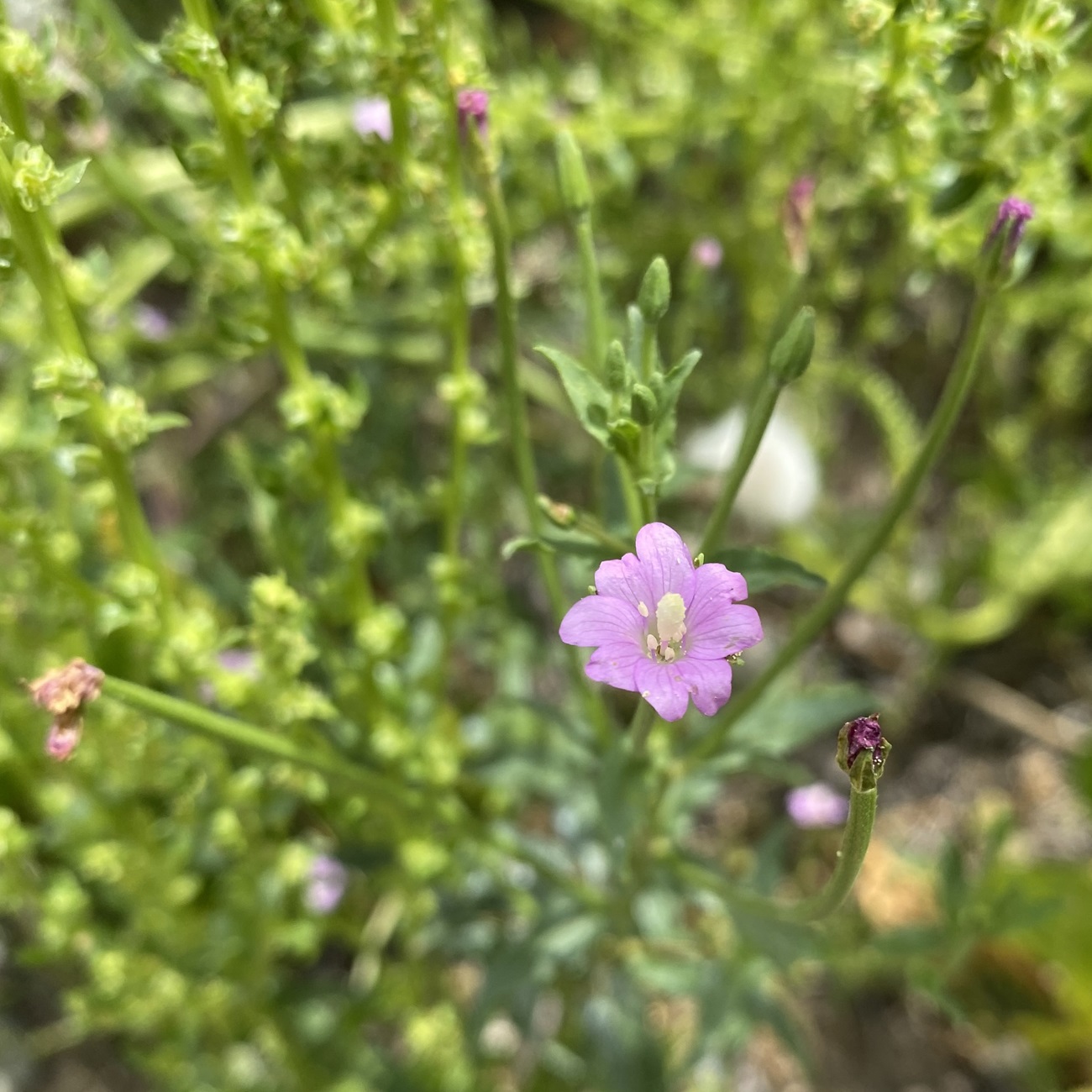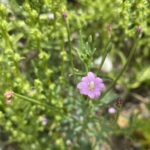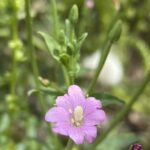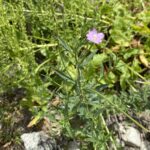Επιλόβιο το τετράγωνο
Etymology of Epilobium tetragonum
"Epilobium" comes from the Ancient Greek "επί+λοβός" [epi+lovos], which means "upon a lobe/pod/capsule" as the flower and capsule appear together, the corolla being borne on the end of the ovary. "Tetragonum" comes from Ancient Greek "τετραγωνο" [tetragono], and it means "square, with four corners, with four sides", referring to its stalk (main stem), which is supposedly square-shaped. If you were to make a cross-section of the stem and look at it under a microscope, you would see four distinct sides or corners, giving it a square appearance.
The Epilobium genus in Cyprus
At least seven Epilobium taxa grow in Cypriot nature, all of them quite uncommon or rare.
Epilobium tetragonum in Cyprus
Epilobium tetragonum is considered a near-threatened plant in Cyprus, a fact that automatically marks it as a quite rare plant. It appears only in central mountainous Cyprus, at an altitude of 150-1525 meters. It primarily grows near streams and moist soil. Its flowering period is between May and July. The sample pictures show specimens photographed in Agios Mamas village, Limassol district, at an approximate altitude of 600 meters.
Key morphology characteristics of Epilobium tetragonum
Stem
Epilobium tetragonum, commonly known as square-stalked willowherb, is an erect perennial that typically grows to a height of 25 to 80 cm, but can reach up to 1.3 meters. This species often has several stems arising from the base. The most distinctive characteristic of Epilobium tetragonum is its stem, which is square-shaped with four conspicuous raised ridges running along its length, particularly in the lower half, while becoming terete in the upper part. The stem is hairless (glabrous) and lacks glandular hairs on both the stem and the inflorescences. Any hairs present are strictly appressed and eglandular.
Leaves
The leaves of Epilobium tetragonum are mostly opposite in arrangement. They are long and strap-shaped, ranging from narrowly oblong to oblong-lanceolate, and are typically 1 to 7 cm in length. The leaf margins are small-toothed or strongly dentate. The leaves are sessile, attaching directly to the stem, and are solid green with a unique shimmer when exposed to direct sunlight. A key feature is that the leaves are evidently decurrent, with the leaf base extending downwards along the stem as raised lines. The leaves themselves are hairless (glabrous). The flowers of Epilobium tetragonum are solitary and found in the upper leaf axils.
The leaves found on the flowering part, or panicle, of Epilobium tetragonum are usually arranged in an alternate pattern, meaning that instead of two leaves growing directly across from each other at the same point on the stem, there is only one leaf at each point, and they appear staggered as you move up the stem. These leaves are often smaller than the ones on the main stem, typically ranging from about 1.5 to 7.5 cm long and 0.3 to 1.5 cm wide. They are often strigillose, which means they have short, bristly hairs that lie close to the surface, especially on the midrib and edges of the leaf. The color is often a dark bluish-green, and sometimes they can have a reddish tint. The shape of these leaves is generally described as narrow and lance-like or narrow and oval-shaped. The edges of the leaves usually have small, even teeth. While the leaves on the main stem are decurrent, meaning their base extends down the stem as raised lines, the leaves on the panicle are not as noticeably decurrent and might appear bent backwards or downwards, which is sometimes called reflexed, due to the way the flowers are arranged.
Flowers
The flowers of Epilobium tetragonum are actinomorphic and typically pink with four notched petals. The petals are 5 to 7 mm in length. The flowers have four notched petals. The stigma of Epilobium tetragonum is undivided and club-shaped (capitate), a crucial characteristic for identification. Additionally, the stigma is wider at the top and narrower below. The calyx consists of four non-persistent sepals and lacks glandular hairs.
Botanical terms explained in simple words
- Square stem: Imagine taking a cross-section of the stem, like cutting a carrot in half and looking at the cut end. In most plants, this cut end would be round. However, the stem of Epilobium tetragonum is square-shaped, meaning if you look at it from the top, it has four distinct sides or corners, rather than being circular. It's like a four-sided pillar instead of a round one.
- Four raised ridges: If you run your finger down the stem of Epilobium tetragonum, you'll feel four lines sticking out along its length. These aren't just lines of color or texture; they are actual raised parts of the stem, like tiny ribs running from the bottom to the top.
- Decurrent leaves: Think of a leaf attached to the stem. In most plants, the leaf stalk (petiole) connects to the stem, and that's it. But in Epilobium tetragonum, the base of the leaf extends downwards along the stem, forming raised lines or wings. It's as if the leaf material "runs down" the stem a little way before stopping.
- Undivided stigma: The stigma is the part of the flower that receives pollen. In many Epilobium species, the stigma is split into four distinct parts or lobes. However, the stigma of Epilobium tetragonum is not divided. Instead, it's a single, solid structure, often described as club-shaped because it's thicker at the top and narrower at the base.
- Actinomorphic flower: When we say the flower of Epilobium tetragonum is actinomorphic, it simply means that the flower has radial symmetry. Imagine a starfish or a daisy – you can draw a line through the center in multiple directions and get two roughly equal halves. So, the flower of Epilobium tetragonum is symmetrical around its central point, like a regular star or wheel.
How to identify Epilobium tetragonum
Epilobium tetragonum reveals similarities with several Epilobiums of Cyprus. Here we compare the five of them to better help you identify Epilobium tetragonum among others:
Epilobium parviflorum is identified by its densely hairy stem and leaves, small (but not the smallest) pink-purple flowers with deeply notched petals, and a 4-lobed stigma that may sometimes appear club-shaped, like that of Epilobium tetragonum. Epilobium lamyi stands out with its soft-hairy-grey upper stem, pubescent median leaves with short petioles, very small pink flowers (the smallest of the Cyprus Epilobiums ranging from 3-5 mm in diameter) arranged in an elongated panicle, and an entire, club-shaped stigma. The presence of long petioles on its lance-shaped leaves, coupled with white flowers that fade to pink and a 4-lobed stigma, are key features of Epilobium lanceolatum. Epilobium tetragonum is perhaps the most distinctive due to its square stem with four raised ridges, along with its hairless, decurrent stem leaves and undivided, club-shaped stigma, which does not elevate above the anthers. Additionally, compared to the other species mentioned in this paragraph is it is the only one with a sessile upper leaf stalk (upper stem leaves, not the inflorescence leaves). Finally, Epilobium tournefortii is characterized by its robust habit, terete stem with appressed hairs, petiolate upper leaves with short petioles, large rose-purple flowers, and an entire, clavate stigma elevated above the anthers.




